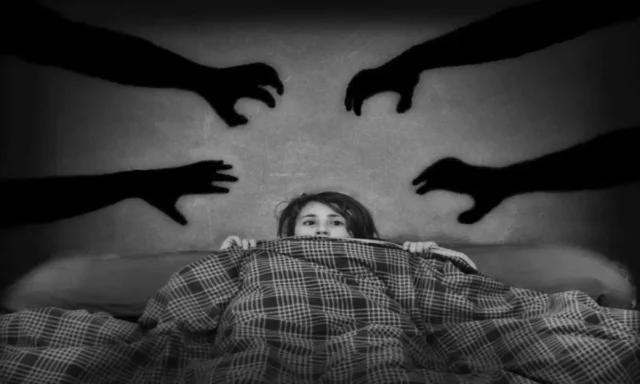With the expansion of the Coronavirus outbreak, the fear of getting sick has increased socially. Many people, who were not significantly concerned about this issue before, begin to have symptoms of nosophobia. That fear helps us set the necessary security limits, but it ends up exceeding and conditioning the person at all levels, even in those moments where there is no risk.
A common fear that has increased
Nosophobia consists of a recurring and persistent fear of contracting a specific disease. It is not the generalized fear that would appear in hypochondriasis, but the person directs it towards something specific. This happens because you have certain diseases linked to your life or because of something that is happening around you. In fact, the fact that there is currently an outbreak of Covid-19 causes this type of phobia to increase, oriented towards that specific disease.
Fear is not only aimed at contracting the disease and suffering it, but also at dying, which is why it is linked to pathologies where life can be in danger and there are real cases of this. Even if the person did not fall into that risk group, for example, it is true that no one would be completely safe, so they would be anchored to that small possibility so that their fear would grow.
The fear of getting sick leads us to obsessive behaviors that would cover multiple areas, such as food, sports, social contact or daily tasks. The person lives in constant alert and controls very well the possibilities of contamination, however remote they may be.
Differences with hypochondria
Hypochondriasis is characterized by constantly focusing on the body and its signals, misinterpreting them and giving the explanation that one is suffering from a disease that no one can diagnose. This produces a high anxiety that would make these symptoms increase. It is not oriented to any disease, but some bodily signals are identified and from there a possible disease is deduced, depending on where you see those same signals. On the contrary, nosophobia is the fear of getting sick from a specific pathology. The person is not convinced that they are already sick, as is the case with hypochondriasis, but rather that they do not want to contract it and live with that concern.
Both produce very high anxiety that could become disabling, with obsessive thoughts of an intrusive nature. They feel that they cannot control their fear and that something bad is going to happen to them. They generate great suffering to those who suffer it and condition their entire lives.
What are the symptoms of nosophobia?
The fear of getting sick has a series of specific signs that make the simple fear already become a phobia. It must be taken into account that a specific disease can scare us if we have seen it in a family member or at a social level, so it may be reasonable for us to be on alert for a while and place more safety barriers. However, this fear of getting sick would lead to added symptoms.
Additionally, the following symptoms are those suffered by a person with nosophobia:

Physical symptoms
Like any type of anxiety or phobia, it has a series of characteristic symptoms related to physical activation; then tachycardia, sweating, headaches and stomach or appetite and sleep disturbances appears. They are not always constant and can appear occasionally throughout the day, but intensely.
Cognitive and emotional symptoms
The predominant emotion is that of fear, with a whole system of thoughts around it. There are circular and obsessive thoughts, which appear recurrently and are very difficult to eradicate. In fact, when they are avoided, they seem to increase. Obsessive ideas do not always have a real foundation.
Behavioral symptoms
When we are afraid of something, we look for a way to avoid it and run away from it in order for it to disappear. We avoid doing related activities or not facing it. However, any avoidance strategy only increases fear and becomes more widespread. What before could be fear of illness from physical contact, for example, ends up making us not touch anyone. Later, this fear increases and we stop getting close to other people, until we limit more and more areas, while the fear only increases.
Nosophobia is not a stage
We go through different moments in our lives that are accompanied by the predominance of a series of emotions, some of which are negative. Grief processes or breakups would bring sadness. Personal conflicts can go with anger or diseases around us with a series of fears. These moments are punctual and the emotions that accompany them too. However, when the state of nosophobia is reached, when the fear of getting sick already conditions the entire daily rhythm and substantially alters the person’s life, a series of mental schemes are generated that make us susceptible to those fears from now on. .
Nosophobia leaves certain patterns and certain conditioned fears in our brain. If now we are afraid of getting sick from Coronavirus, in the future we will associate contact with other people, for example, with contracting other pathology. We will maintain the fear but we will be able to change the disease in the long term. This means that it is not a stage that as soon as it comes, it goes away; however, we may need help that allows us to discard those schemes.
How to treat nosophobia
Like any type of phobia, it is easier to eliminate in the early stages, when it has not yet reached that category and it is just a fear. However, regardless of the state we find ourselves in, phobias can always be treated and eliminated, although it may take longer.
The fear of getting sick is associated with different treatments, some of them only applicable by a psychologist:
Distractions- Keeping busy, being distracted and enjoying what we do is a good first step. It is time to find activities that satisfy us.
Relaxation- Both at times, when we feel anxiety, and throughout the day, we must use relaxation techniques, such as breathing, mindfulness, or yoga.
Cognitive restructuring- Irrational thoughts related to the disease are identified and alternative ones are generated.
Exposure to the problem- The ideal is to carry out techniques in imagination that help us calm down in the face of our fear. It is always done with the help of a professional.


